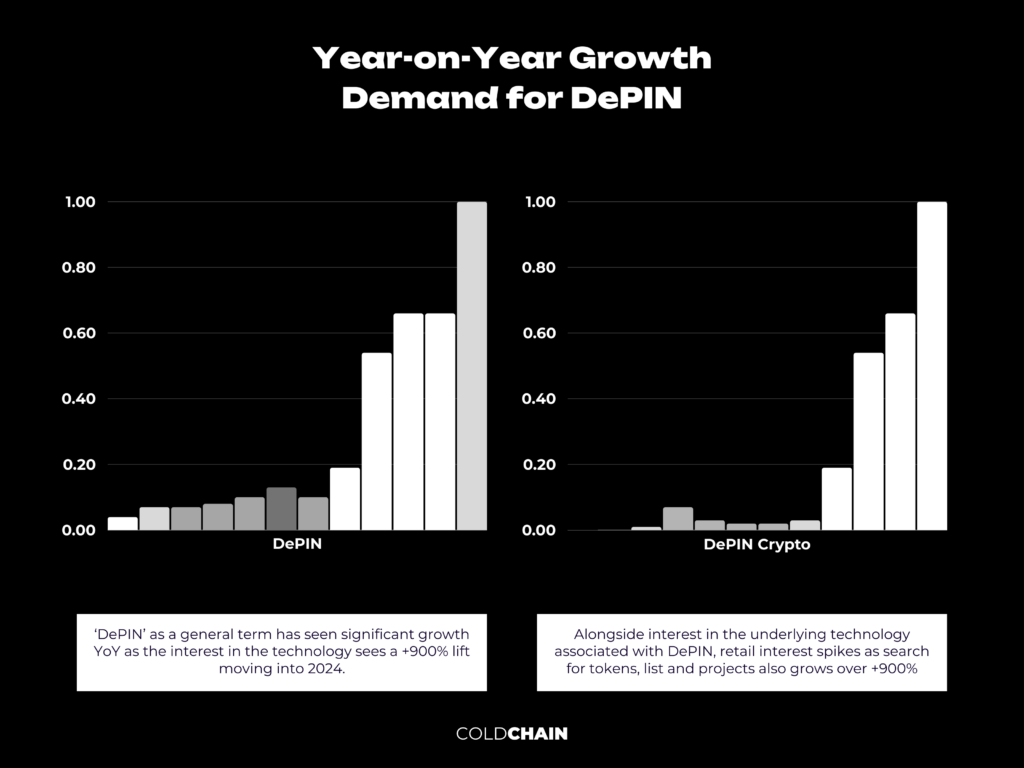Need Support for your Project? Let’s Talk.
This article explores the growth of Real World Assets (RWA) & Decentralised Physical Infrastructure Networks (DePIN). As the industry evolves, these segments are becoming increasingly significant due to their potential to bridge traditional financial assets with blockchain technology. This article covers market trends, adoption rates, and key narratives.
Market Trends

With the macro sentiment surrounding crypto and tokenisation drives forward on the heels on the ETH ETF (at this time of writing) and the adoption of Bitcoin ETF, more and more institutional interest and market demand is coming to crypto and blockchain. With that, we take a look at new areas gaining traction, adoption and interest in the space.
DePIN
Decentralised Physical Infrastructure Networks (DePIN) involves decentralised management and ownership of physical infrastructure such as energy grids, transportation networks, etc. via the use of blockchain. As of the time of writing, DePIN’s market cap sits around $30.2B.
Example Projects:
Helium Network

Helium is a decentralised wireless network that enables devices to connect to the internet through community-operated hotspots. It uses a blockchain-based incentive model to reward participants with Helium tokens (HNT) for providing network coverage.
Peaq

Peaq, a layer-1 blockchain allows anyone to develop decentralised applications (dApps) and Decentralised Physical Infrastructure Networks (DePINs) for car-sharing, street-mapping, web access, and more, generating real-world value as part of the Economy of Things. Recently joining the Mastercard Start Path program.
Key Narratives Driving DePIN Adoption
Sustainability
Supporting sustainable development through decentralised renewable energy projects. A long-held narrative is that crypto utilises too much energy and hasn’t historically been seen as a ‘green’ asset, moving forward, DePIN and other technologies can look to benefit the environment.
Innovation
Being aligned to innovations is a powerful message and narrative for more traditional web2 enterprises and brands, a huge narrative at play previously was that of ESG, seeing many brands adopt and change to fit this new narrative. Given the innovation behind DePIN protocols, we can expect brands will want to align their product with this new innovative space.
Decentralisation of Infrastructure
The leading narrative and application of DePIN will be that of decentralised ownership across infrastructure. While it may be challenging to bring this into the real world, the appeal of greater transparency, community ownership and enhanced security may well speak to many.
Search Demand
Search demand for ‘DePIN’ hits its all-time-high moving into May 2024, alongside direct interest in technology, interest and research into associated DePIN projects and tokens also hits new highs. This surge in demand applies to all users searching across the US on search engines.

Which Projects are Winning?

Peaq Network have firmly aligned with DePIN, as a result when DePIN demand spiked, their visibility grew in direct correlation allowing them to be front-of-mind for many users discovering DePIN.

Real World Assets (RWA)
Real World Assets (RWA) refer to the tokenisation of tangible physical assets that are brought onto the blockchain. This category also includes the increasing issuance of capital market products on-chain, where digital securities are tokenised and made available to retail customers. At the time of writing, RWA Market cap sits around $8B.
Example Projects:
Centrifuge

A decentralised platform that connects real-world assets (RWA) to decentralised finance (DeFi). It allows businesses to tokenise assets like invoices and real estate, using them as collateral to access liquidity through DeFi protocols, providing a transparent and efficient way to finance their assets.
OriginTrail

A decentralised network designed to enhance supply chain transparency and integrity. It uses blockchain technology to securely and immutably track and verify the journey of goods and assets through complex supply chains. It aims to improve efficiency in various industries, including food, pharmaceuticals, and logistics.
Key Narratives Driving RWA Adoption
Tokenisation
Enabling the creation and trading of tokens that represent ownership or usage rights for infrastructure, fostering a new economy of decentralised services. Allowing for a lower entry barrier to high-cost assets such a real estate and other high-purchase items.
Institutional Interest
Increasing interest from traditional financial institutions seeking to leverage blockchain for asset management, the underlying technology and bringing tangible assets onchain.
Stablecoin Usage & Yield Baring Assets
The rise of stablecoins backed by RWAs can provide stability in volatile markets and act as a yield-bearing asset for those holding the asset.
Diversification
Investors seeking diversified portfolios with tokenised real estate, commodities, and other RWAs. With the ongoing issues surrounding inflation and weakening conditions, diversification into RWA backed assets will likely be an appealing narrative.
Search Demand
A core area seeing growth within RWA is the acceleration and demand surrounding Real Estate Tokenisation. Several established web3 protocols are bidding and shifting toward capturing more attention from web2 enterprises and those searching for tokenization solutions within the real estate sector.
As an early space, there is opportunity for a project to emerge and establish themselves as a ‘go-to’ protocol for brands entering the space.

How RWA & DePIN Projects Can Grow Moving Forward

The future outlook for Real World Assets (RWA) and Decentralised Physical Infrastructure Networks (DePIN) in the crypto industry is highly promising. From a marketing perspective, several key trends and strategies can shape the growth and adoption of these technologies.
1. Increased Awareness and Education
- Marketing Strategy: Develop comprehensive educational campaigns to inform potential users and investors about the benefits and functionalities of RWA and DePIN.
- Impact: Increased understanding will drive adoption as more people recognise the value of tokenising real-world assets and participating in decentralised infrastructure projects.
2. Institutional Adoption
- Marketing Strategy: Target institutional investors and traditional financial institutions with tailored enterprise marketing efforts showcasing the security, transparency, and efficiency benefits of blockchain-based assets.
- Impact: Institutional adoption will bring credibility and substantial capital to the market, accelerating growth and broader acceptance.
3. Partnerships and Collaborations
- Marketing Strategy: Form strategic partnerships with industry leaders, tech companies, and regulatory bodies to enhance the ecosystem and create a supportive environment for RWA and DePIN.
- Impact: Collaborations will help integrate these technologies into existing systems, making it easier for businesses and consumers to adopt and benefit from them.
4. Innovative Use Cases and Success Stories
- Marketing Strategy: Highlight successful projects and innovative use cases in marketing campaigns to demonstrate real-world applications and benefits.
- Impact: Showcasing tangible results will build trust and interest, encouraging more users to explore and invest in RWA and DePIN.
5. Regulatory Clarity and Compliance
- Marketing Strategy: Emphasise compliance with regulatory standards in marketing materials to reassure potential users about the legitimacy and safety of investing in tokenised assets and decentralised networks.
- Impact: Clear regulatory frameworks will reduce uncertainty and risk, making these technologies more attractive to a wider audience.
6. User-Friendly Platforms
- Marketing Strategy: Focus on developing and marketing user-friendly platforms that simplify the process of tokenising assets and participating in DePIN.
- Impact: Lowering the technical barriers will attract a broader user base, including those who may not be familiar with blockchain technology.
7. Enhanced Security Measures
- Marketing Strategy: Promote advanced security features and protocols that protect user assets and data, addressing common concerns about hacking and fraud.
- Impact: Enhanced security will build trust and confidence, essential for attracting new users and investors to the market.
8. Sustainability and Social Impact
- Marketing Strategy: Leverage the sustainability and social impact aspects of DePIN projects, such as decentralised renewable energy grids and transparent supply chains, to attract socially conscious investors and consumers.
- Impact: Highlighting these benefits will resonate with a growing demographic of environmentally and socially aware users, driving adoption and positive brand perception.
Conclusion
The future outlook for RWA and DePIN is bright, with significant growth potential driven by strategic marketing efforts focused on education, institutional adoption, partnerships, innovative use cases, regulatory compliance, user-friendly platforms, security, and sustainability. By effectively communicating the benefits and addressing the concerns of potential users, the marketing strategies will play a crucial role in driving the widespread adoption and success of these transformative technologies.
Does your RWA or DePIN Project Need Marketing Support?
Ready to talk? Complete the form below and we will come back to you ASAP!



